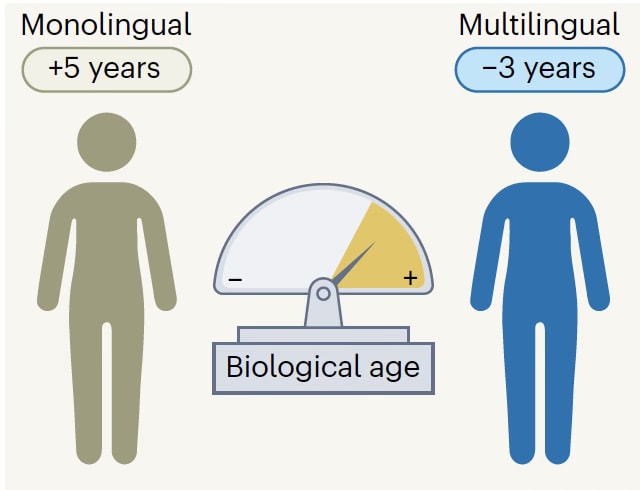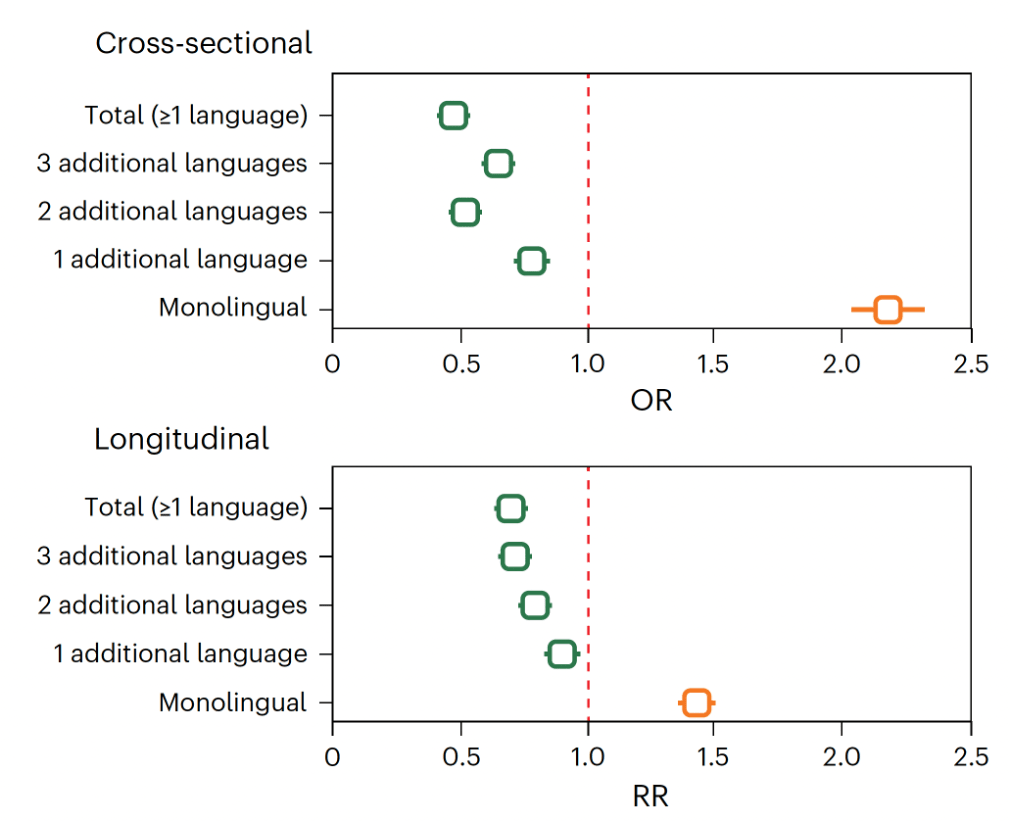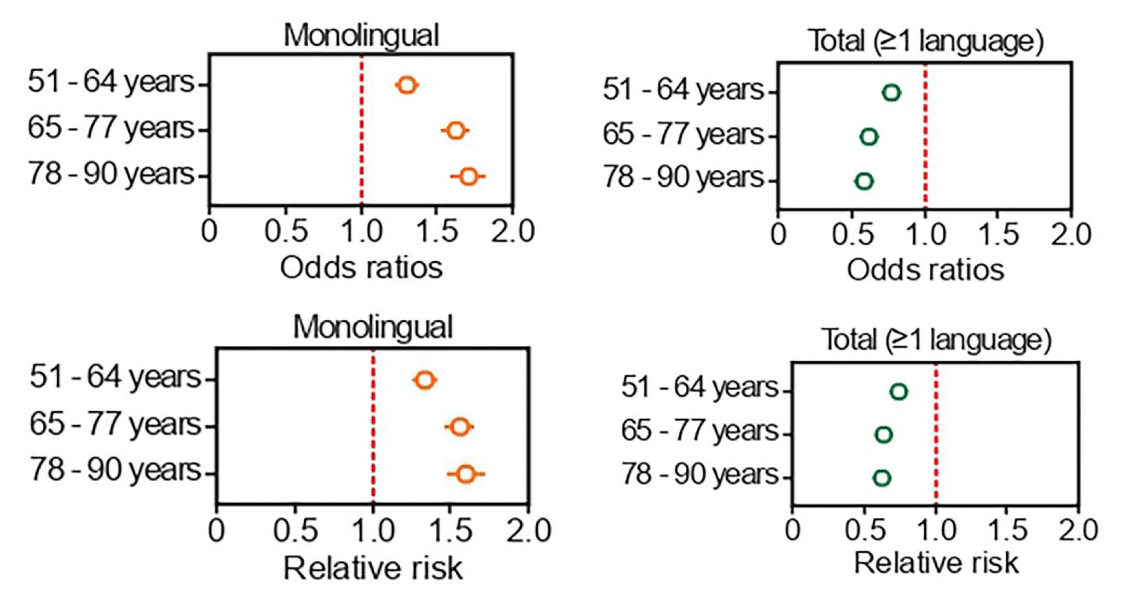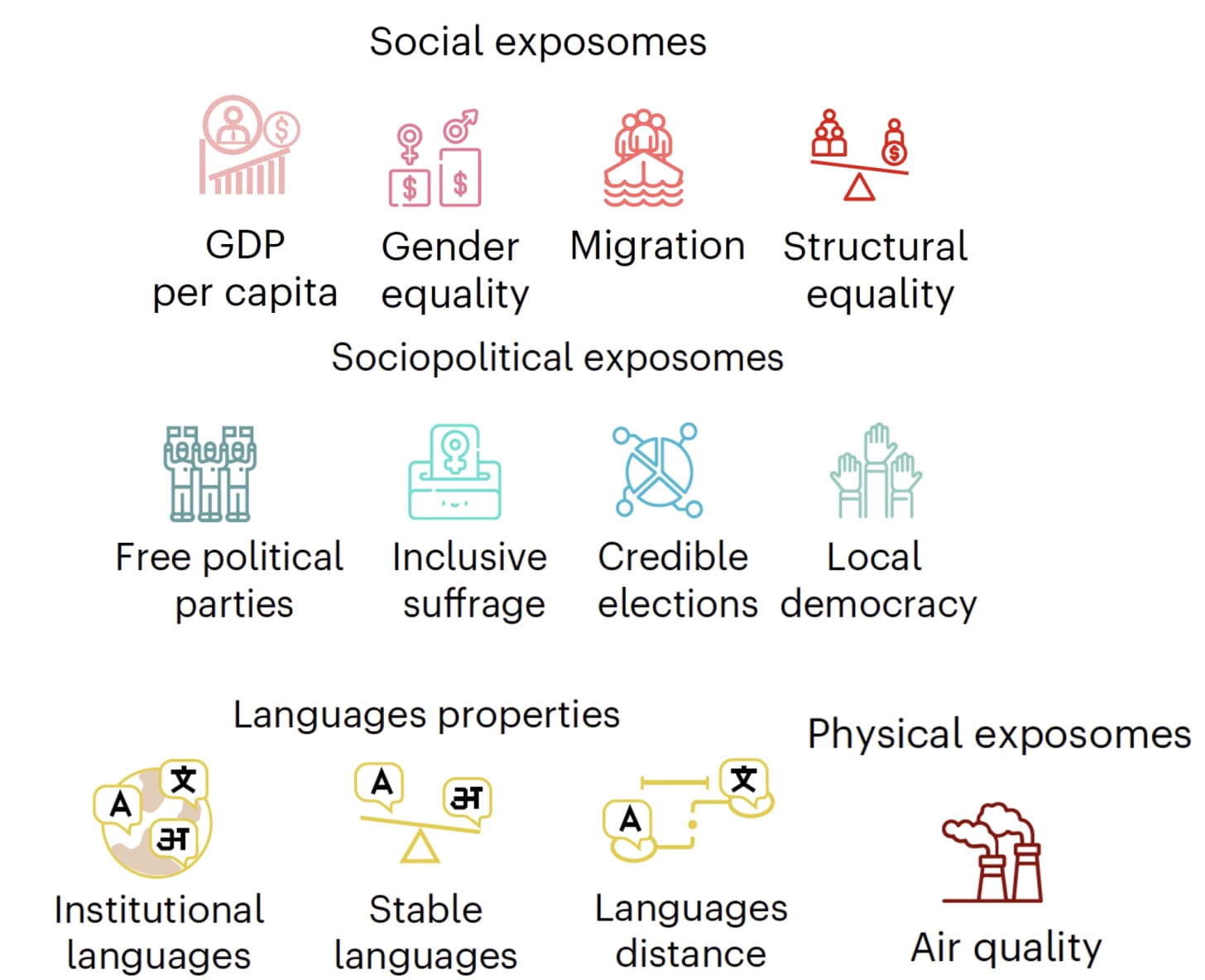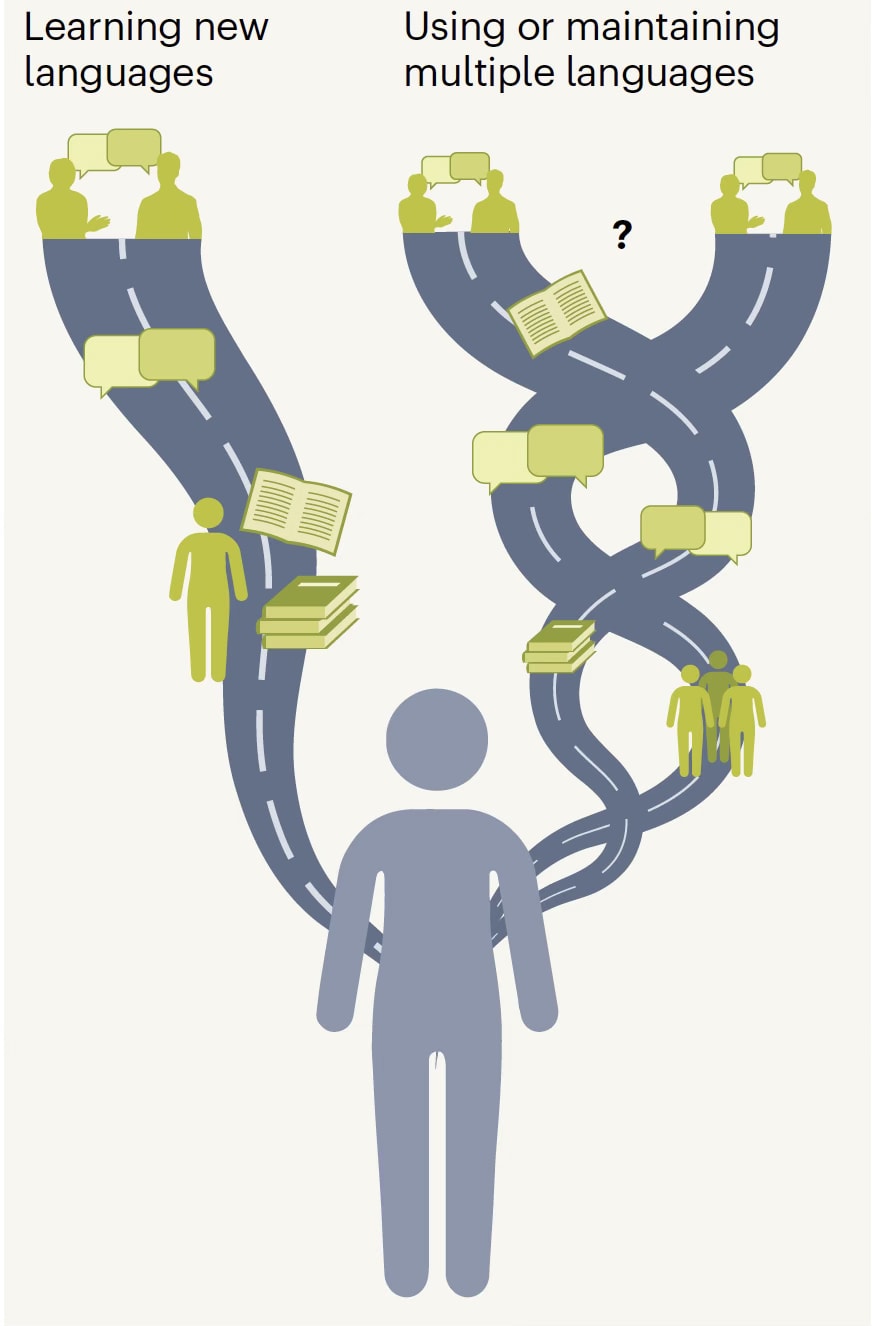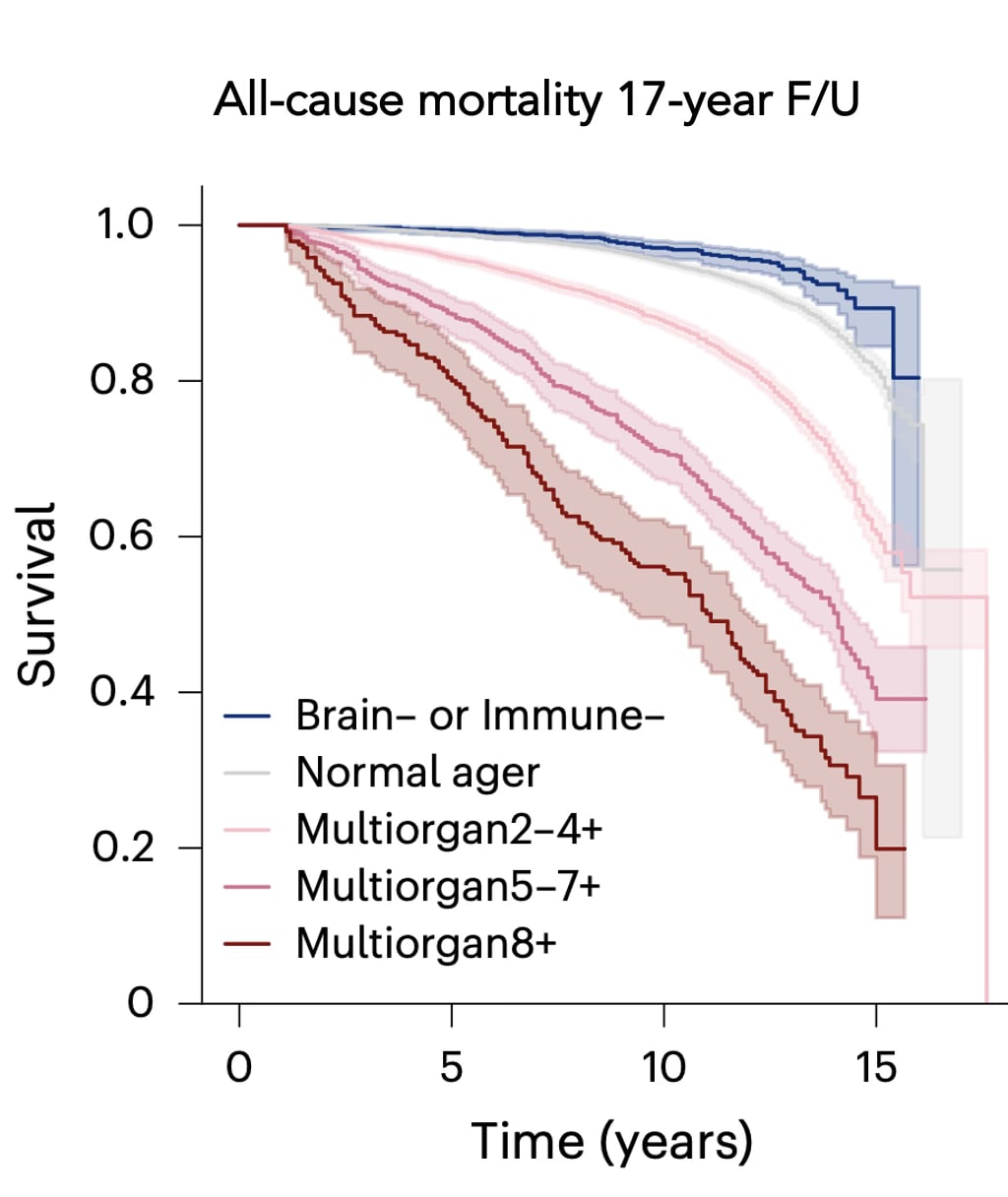What if learning a second language could provide you 3 more years of healthy aging or, alternatively, speaking only your mother’s tongue was linked to a loss of 5 years of healthspan? These are the implications of an important new study published today. First, let’s review a bit of background.
Over the past two decades there have been many reports that multilingual individuals have improved cognition compared with their monolingual counterparts with better attention, task switching, working memory and potential protection from Alzheimer’s disease. It’s not just advantages for functionality. Brain structure studies in multilingual vs monolingual participants have shown increased gray matter density in key regions (caudate nucleus, left inferior parietal cortex) that are linked to executive function, such as this frequently cited 2004 paper (Figure below). This feature is known as neuroplasticity—the brain’s ability to change and reorganize its neural connections throughout life. Note how the gray matter density increase is maximum when proficiency in a second language occurs as a younger age.
Most of the studies of multilingualism’s benefits have been small, with confounders, and mainly focused on the brain and cognitive function. Today, the new report in Nature Aging provides a far more comprehensive picture. In this edition of Ground Truths, I’ll review the paper, its limitations, and where we go from here.
Agustin Ibañez, from the Global Brain Health Institute and Scientific Director of the Latin American Brain Health Institute, along with colleagues throughout Europe, published a study of over 86,000 adults from age 51 to 90, mean age 66.6, from 27 countries in Europe. They developed a biobehavioral age gap (BAG), like body-wide or organ clocks, that are a metric of the pace of aging of an individual or organ, from all the known risk and protective factors, some of which are shown below. Multi- or mono-lingualism was derived from country level data. Individuals underwent repeat national surveys for all the known protective and risk factors on a longitudinal basis. The survey questions are published in the Supplementary data.
There were 3 major analyses, one by cross-section (aggregate data for multi vs mono-lingual), longitudinal data that factor in time of follow-up, and a subgroup analysis by age. In the cross-sectional analysis, monolinguals were 2.1 fold more likely to develop accelerated aging whereas those speaking one or more languages were 2.2 time less likely (odds ratio of 0.46) to experience accelerated aging. For the longitudinal analysis, the risk ratio for monolinguals was 1.4 fold for accelerated aging, and 1.4 fold less for multilingual. You can see the dose response with increased additional languages and more protection, i.e. less likely for developing accelerated aging. Correspondingly, the age subgroups for the cross-sectional (top) and longitudinal (bottom) of the graph at bottom below shows the risk or protection to be present across all ages, increasing risk of accelerated aging in monolinguals with increasing age. In contrast, the multilinguals with 2 or more additional languages had more protection within older age groups (data not shown below, in Extended Figure 1 of paper).
The compelling part of the report s the depth of analysis and stress testing of their results. They controlled for everything possible (education, cognitive function, physical activity, etc), including all different types of exposures (exposomes), some of which are shown below, leaving out country analyses, multiple tests and optimization of their model, and a blitz of sensitivity analyses.
There were a couple of nuances from the analyses worth noting. Two categories—migrants and gender inequality— showed blunting of benefit for multilingualism. That may be due to the fact that migrants are forced, rather than electively choosing to learn a new language, and for women experiencing social constraints.
The are some important limitations to acknowledge. The robust analyses are providing strong associative links, not establishing cause and effect. The results are restricted to European countries where multilingualism may be more common and not representative of other parts of the world. The national level data used for categorizing monolingualism or multilingualism is not nearly as helpful as what would have been garnered at the individual level. Furthermore, we have no idea when a person learned a new language and how proficient or how frequent the language was spoken. All of the prior data would have suggested the benefit of multilingualism related neuroplasticity is enhanced over time, when adopted at younger ages, but data in the new report leave this matter clouded
The use of the BAG here is of interest, providing a metric to show protection from accelerating aging. But that could be corroborated by brain clocks, using proteomics to determine the brain pace of aging, which have previously and consistentty been shown to be a critical determinant of lifespan and healthspan (Figure below, as previously reviewed in Ground Truths). Other biological clocks such as DunedinPACE using methylation would also be helpful.
So, while there are a few holes in the story, the new study takes multilingualism to a much higher tier of respect for it representing an independent and modifiable risk factor for healthy aging, well beyond cognitive function that previously has been the focus. In my SUPER AGERS book I reviewed all the known— what I called “lifestyle plus factors” —since there are so many beyond exercise, diet and sleep. I would now add multilingualism, based on this new report, as a lifestyle plus factor. It is certainly low cost and eminently scalable. Yes, there are residual uncertainties, but there’s a lot more here than any anti-aging supplement, or evidence of benefit from a longevity clinic or company, and at no risk. As the accompanying commentary asserted: “multilingual usage across the lifespan could be as important as campaigns that promote physical activity, or smoking cessation.” I’m not multilingual, although I took French through college. Now I’m regretting that I didn’t keep it up and even contemplating learning it and using it again. You folks who learned a 2nd (and 3rd) language as a kid and still use it are the lucky ones!
Poll
*******************
Thanks you for reading and subscribing to Ground Truths.
If you found this interesting PLEASE share it!
That makes the work involved in putting these together especially worthwhile.
All content on Ground Truths—its newsletters, analyses, and podcasts, are free, open-access. No ads.
Paid subscriptions are voluntary and all proceeds from them go to support Scripps Research. They do allow for posting comments and questions, which I do my best to respond to. Please don’t hesitate to post comments and give me feedback. Let me know topics that you would like to see covered.
Many thanks to those who have contributed—they have greatly helped fund our summer internship programs for the past two years. It enabled us to accept and support 47 summer interns in 2025! We aim to accept even more of the several thousand who will apply for summer 2026.
.png)

